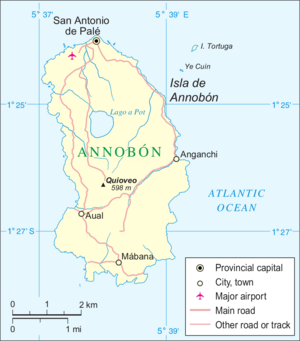Quioveo facts for kids

Quioveo is an extinct volcano located right in the middle of Annobón island. This island is part of Equatorial Guinea, a country in Africa. Quioveo is the highest point on Annobón, reaching a height of 598 meters (about 1,962 feet) above sea level.
Contents
What is Quioveo?
Quioveo is what we call a volcanic peak. This means it's the top part of a volcano. When we say it's "extinct," it means the volcano is no longer active. It's not expected to erupt again. Think of it as a sleeping giant that won't wake up.
Annobón Island
Annobón is a small, beautiful island in the Atlantic Ocean. It's known for its green hills and clear waters. The island was formed by volcanic activity, just like Quioveo. It's a remote place, meaning it's far away from big cities.
Location and Geography
Annobón is located south of the equator, in the Gulf of Guinea. It's a tiny island, only about 17 square kilometers (6.6 square miles) in size. Quioveo sits right in the center, making it a key part of the island's landscape. The island's volcanic past has created a rugged but beautiful terrain.
Part of the Cameroon Line
Quioveo and Annobón island are part of something called the Cameroon line. This is a chain of volcanoes that stretches from the Atlantic Ocean into mainland Africa. It's like a long line of mountains and islands, all formed by volcanic activity.
Other Volcanoes in the Line
The Cameroon line includes several other famous islands and mountains:
- São Tomé Island: Another volcanic island, known for its cocoa farms.
- Príncipe: A smaller island near São Tomé, also volcanic.
- Bioko: A larger island that is also part of Equatorial Guinea. Its highest point is Pico Basile, another volcano.
- Mount Cameroon: A very active volcano on the mainland of Africa, in the country of Cameroon.
All these places were created by hot rock (magma) pushing up from deep inside the Earth. Over millions of years, these eruptions built up the land, forming islands and mountains. Quioveo is a quiet reminder of this powerful geological process.
See also
 In Spanish: Pico Quioveo para niños
In Spanish: Pico Quioveo para niños


